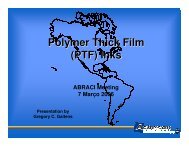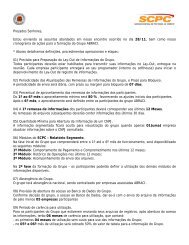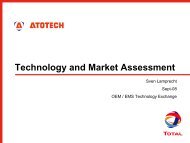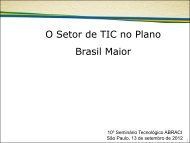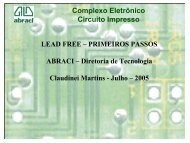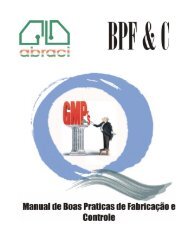BOAS PRÃTICAS DE FABRICAÃÃO E CONTROLE - ABRACI ...
BOAS PRÃTICAS DE FABRICAÃÃO E CONTROLE - ABRACI ...
BOAS PRÃTICAS DE FABRICAÃÃO E CONTROLE - ABRACI ...
You also want an ePaper? Increase the reach of your titles
YUMPU automatically turns print PDFs into web optimized ePapers that Google loves.
1 Acceptability of Electronic Assemblies 1-1<br />
1.1 Scope 1-1<br />
1.2 Purpose 1-1<br />
1.3 Specialized Designs 1-2<br />
1.4 Terms & Definitions 1-2<br />
1.4.1 Classification 1-2<br />
1.4.2 Customer Responsibility 1-2<br />
1.4.3 Acceptance Criteria 1-2<br />
1.4.3.1 Target Condition 1-2<br />
1.4.3.2 Acceptable Condition 1-3<br />
1.4.3.3 Defect Condition 1-3<br />
1.4.3.4 Process Indicator Condition 1-3<br />
1.4.3.5 Conditions Not Specified 1-3<br />
1.4.4 Board Orientation 1-3<br />
1.4.4.1 Primary Side 1-3<br />
1.4.4.2 Secondary Side 1-3<br />
1.4.4.3 Solder Source Side 1-3<br />
1.4.4.4 Solder Destination Side 1-3<br />
1.4.5 Electrical Clearance 1-3<br />
1.4.6 Cold Solder Connection 1-3<br />
1.4.7 Leaching 1-4<br />
1.4.8 Meniscus (Component) 1-4<br />
1.5 Examples and Illustrations 1-4<br />
1.6 Inspection Methodology 1-4<br />
1.7 Verification of Dimensions 1-4<br />
1.8 Magnification Aids and Lighting 1-4<br />
2 Applicable Documents 2-1<br />
2.1 IPC Documents 2-1<br />
2.2 Joint Industry Documents 2-1<br />
2.3 EOS/ESD Association Documents 2-2<br />
2.4 Electronics Industries Alliance Documents 2-2<br />
2.5 International Electrotechnical Commission<br />
Documents 2-2<br />
3 Handling Electronic Assemblies 3-1<br />
3.1 Electrical Overstress (EOS) Damage<br />
Prevention 3-2<br />
3.2 Electrostatic Discharge (ESD) Damage<br />
Prevention 3-3<br />
3.2.1 Warning Labels 3-4<br />
3.2.2 Protective Materials 3-5<br />
3.3 EOS/ESD Safe Workstation/EPA 3-6<br />
3.4 Handling 3-8<br />
3.4.1 Guidelines 3-8<br />
3.4.2 Physical Damage 3-9<br />
3.4.3 Contamination 3-9<br />
3.4.4 Electronic Assemblies 3-9<br />
3.4.5 After Soldering 3-10<br />
3.4.6 Gloves and Finger Cots 3-11<br />
4 Mechanical Assembly 4-1<br />
4.1 Hardware 4-2<br />
4.2 Hardware Mounting 4-3<br />
4.2.1 Electrical Clearance 4-3<br />
4.2.2 Excess Solder 4-4<br />
4.2.3 Threaded Fasteners 4-5<br />
4.2.3.1 Minimum Torque for Electrical Connections 4-8<br />
4.2.3.2 Wires 4-9<br />
4.2.3.3 High Voltage Application 4-11<br />
4.2.4 Component Installation 4-12<br />
4.2.4.1 High Power 4-12<br />
4.2.4.2 Hole Obstruction of Solder Fill 4-14<br />
4.3 Swaged Hardware 4-15<br />
4.3.1 Flared Flange 4-16<br />
4.3.1.1 Controlled Split 4-17<br />
4.3.2 Flat Flange - Fused-in-Place 4-19<br />
4.3.3 Terminals 4-21<br />
4.4 Component Mounting 4-22<br />
4.4.1 Mounting Clips 4-23<br />
4.4.2 Adhesive Bonding - Non-Elevated<br />
Components 4-25<br />
4.4.3 Adhesive Bonding - Elevated Components 4-27<br />
4.4.4 Wire Hold Down 4-28<br />
4.4.5 Cable Ties, Tie Wraps, Spot Ties 4-29<br />
4.4.6 Lacing 4-32<br />
4.4.7 Wire Dress for Terminations to Connectors<br />
Without Strain/Stress Relief 4-33



